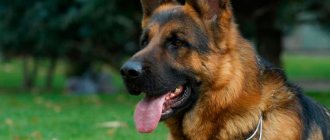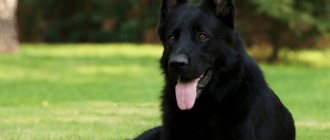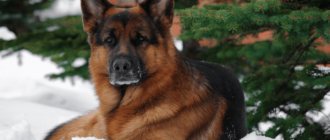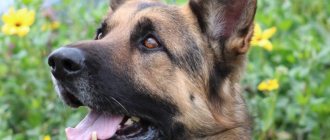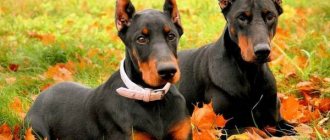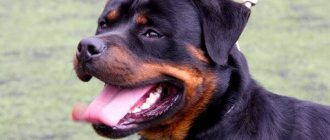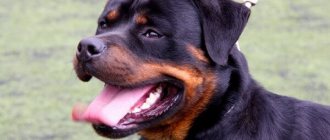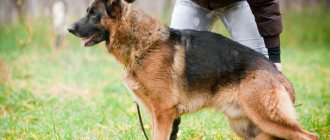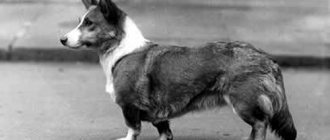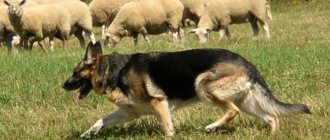The German Shepherd was bred to work and its working qualities are often the main criterion when choosing a future pet.
Currently, the breeding of these dogs is divided into exhibition and working.
Breeders of working lines focus on the performance qualities of their dogs, paying less attention to exterior characteristics.
Often in working lines there are dogs with an undesirable color and coat type for show dogs.
However, at the same time, they are distinguished by outstanding working qualities and are the holders of many diplomas from training competitions.
Origin story
By the 7th century AD In Germany, herding dogs similar to modern German shepherds already existed. These were large and strong animals, distinguished by their devotion to their owner, distrust of strangers and moderate viciousness.
These dogs were mainly used to herd livestock, but they could also perform other jobs, such as guarding the farm or protecting the owner.
It was they who became the founders of the new breed, when in the second half of the 19th century, targeted work began on breeding a universal dog, which became the embodiment of the best working and exterior qualities of ancient shepherd dogs.
In the first breed standard , drawn up in 1899, paramount importance was given to the working and service qualities of representatives of the new breed .
According to him, a German Shepherd should have a strong nervous system and character traits such as courage, confidence and inflexibility in achieving goals.
Subsequently, the standard was repeatedly rewritten, and when breeding show shepherd dogs, exterior characteristics came to the fore.
This is precisely the reason that some breeders, who believe that the dog’s character is of paramount importance, began to breed dogs that are distinguished by excellent working qualities, although they are inferior to their show relatives in appearance.
Description and why they are purchased
The German Shepherd of working breeding is not created for conquering the exterior rings. But on the other hand, she is better suited to the most complex and difficult work than her show relatives.
It is these dogs that make wonderful service dogs used in the army, law enforcement agencies and rescue services. They are also used for their original purpose: they still graze livestock and protect them from predators.
People who are not related to the special services and the army also get such shepherd dogs . First of all, this is done by those who dream of playing sports with their pet.
And, indeed, German Shepherds of working breeding show outstanding results in various sports disciplines and in training competitions.
After all, strength and malice are combined in them with a strong temperament and an unshakable will to win.
People who do not want to engage in sports with their pet, participate in training competitions, or have no intention of using it to work in the special services, should not buy a working-bred shepherd dog..
Nurseries
The most reliable way to purchase a healthy, purebred puppy with working functions is to visit a specialized nursery.
List of the most popular German Shepherd kennels:
Team Bulle Hof
The nursery has been operating since 2002. Located in Moscow. Has many awards and certificates. Breeders are engaged in breeding, preparation for exhibitions and training there. On the official website you can find all the necessary information.
Dog kennel "Rus Lindeshof"
The nursery was opened in Kaluga in 1988. It sells titled individuals. Dog handlers not only breed German Shepherds, but also Chihuahuas and Chow Chows.
Singer Rotwal
Representatives of the pet industry from Kazan. They are engaged in the breeding of German Shepherds, Toy Terriers and Rottweilers.
"SIEBEN WIND" RKF-FCI
Moscow mononursery. Was founded in 1987. Champions of Russia, RKF. They have awards and certificates.
"Police Dog"
Rostov-on-Don. Shepherd dogs are trained there for home guarding and law enforcement service.
Pet character
The working German Shepherd has a strong temperament and is highly people-oriented. She works not under compulsion, but at will.
This dog is not afraid of the most difficult conditions and heavy physical activity . Shepherd dogs of working breeding are stress-resistant and hardy, they rarely have nervous breakdowns.
NOTE!
At the same time, these dogs are more vicious and stubborn than show dogs; in addition, they are more active and require more physical activity.
A working-bred shepherd dog needs a strong and confident owner; in addition, these dogs must be trained professionally.
Interesting Facts
- Descendants of German Shepherds from Scandinavia. But the blood of wild wolves also flows in them. Greif is the first representative of the breed to be shown in Hannover at an exhibition in 1882. The founder of a separate species was Max von Stefanitz.
- German Shepherds are excellent shepherds. Their historical purpose was to protect sheep. But during wars, they became experienced soldiers at the front.
- These individuals were not only participants in military operations. They worked as sappers, orderlies and signalmen. One dog, named Khan, was even awarded a medal for courage and bravery.
- The German breed is officially recognized as one of the three smartest in the world. Only representatives of the collie and the poodle were able to get around it. The ranking was compiled by British University psychologist Stanley Coren.
- A strong jaw is a hallmark of the German Shepherd. The bite is 100 kg. According to this value, only Rottweilers and some Pid Bulls are ahead of them.
- In Russian Tolyatti, residents erected a monument called “Devotion.” It is dedicated to the German Shepherd. Canadian architects have recreated the image of a four-legged creature, reminiscent of dead police dogs.
- These dogs are often featured in films and TV series. They play the role of assistants to the detective department.
This is interesting: TOP 20 smartest dogs in the world
This is interesting: TOP 20 smartest dogs in the world
Breed standard
Height ranges from 55 to 63 cm, weight – from 22 to 35 kg .
The body shape is a little stretched. The length should exceed the height at the withers by 10-15%: these are the proportions that ensure the dog’s greatest performance and endurance.
The muscles are well developed, making the dog look strong, agile and agile.
The head has the appearance of a narrow wedge tapering towards the nose . The ears are erect, medium in size, wide at the base. The nose is not too large, black.
The jaws are strong and powerful. The teeth are complete, large, white and strong. The bite is regular, scissor-shaped. The eyes are small, oval, preferably as dark a shade as possible.
The neck is muscular, strong and strong, set at approximately 45 degrees. The back is straight and level, the croup is only slightly sloping (15-20 degrees).
The main external difference between a working shepherd dog and a show dog is not a convex, but an almost straight line of the back . The croup also does not have such a strong slope as in show dogs.
The tail is slightly curved and reaches the hocks.
The forelimbs are straight and even, located at right angles, and the hind limbs are slightly set back.
A shepherd dog of working breeding can have either rather short and stiff or long and softer hair .
Expert opinion
Kozhevin Semyon Kirillovich
Expert dog handler.
“Work-bred German Shepherds have a bolder and tougher character than show-bred dogs. They are more energetic, resilient and mobile. Dogs with a melancholic or phlegmatic character are excluded from working breeding, as well as those that do not have great endurance and psychological stability. But, despite the fact that working shepherd dogs have such attractive qualities, they cannot be kept as companion dogs. These animals live for work, and if the owner cannot provide the pet with an activity that requires the application of its innate qualities, it is better for him not to buy such a dog.”
Basics of genetics
Always choose your breeding pairs wisely to ensure your dogs meet the standard. Judging only by how a German Shepherd looks externally is the wrong approach. It is worth fully mastering the genetics of succession.
What you need to know
All dogs have thirty-nine pairs of chromosomes, for a total of seventy-eight. In females, all chromosomes are similar in a pair; in males, only thirty-eight pairs are akin; the remaining pair are sex chromosomes, and they are different.
The genes responsible for the characteristic traits of heredity are stored in chromosomes. If genes are located in paired chromosomes at the same place, then they are called “allelic”.
The individual genotype of the offspring is inherited from both the mother and the father. If genes with a specific feature inherited from parents are the same, then they are called homozygous. When the genes are different, they are called heterozygous.
If a trait received from the mother or father is clearly expressed in the offspring, it means it is dominant. If the trait is hidden, then it is called repressive. There are times when the dominant may be incomplete.
There are three laws of genetics:
- first generation law of uniformity;
- second generation law of splitting;
- law of independent splitting of characteristics.
Genotype cannot be determined by appearance alone.
Your main task as a breeder is to determine the most successful type of cross.
Basic colors
The main color is zone-gray , although there are also dogs of other shepherd colors: zone-red, black and tan, black and saddle.
For a working shepherd, color is not particularly important, since when breeding them, the emphasis is on physical and psychological characteristics.
Advantages and disadvantages
pros:
- Hardy and efficient.
- Selflessly devoted to their owner.
- Mentally stable.
- Unpretentious in food.
- They are easy to care for.
- They make wonderful working or sporting dogs.
- Show high results in sports championships and training competitions.
Minuses:
- They don't look as impressive as show dogs.
- They require enormous physical activity and work.
- If raised incorrectly, they can grow into animals that pose a potential danger.
- The owner of such a shepherd can only be an adult and physically strong person with pronounced leadership qualities.
- Cannot be kept as companion dogs.
A working breed dog is only suitable for active work . Even for use as a home security guard, it is not recommended to use it.
How to treat children and pets
A properly raised working-bred shepherd dog is good with children, but this does not mean that it can be used as a nanny dog.
However, these animals willingly take part in active games and are ready to protect their little owners, not sparing their lives.
These shepherds are pets without excessive aggression . But it is unlikely that such a dog will be supportive of a strange dog or cat entering his territory.
Life expectancy, illness and health
Life expectancy is, on average, from 10 to 14 years .
When breeding working line shepherd dogs, breeders try to use only healthy dogs that are not carriers of hereditary diseases.
Nevertheless, albeit infrequently, such a shepherd may be predisposed to the following ailments:
- Diseases of the gastrointestinal tract.
- Hip dysplasia.
- Hind leg failure.
- Allergies are mainly food allergies.
- Dermatitis caused by improper feeding.
- Otitis.
Working dogs are more likely to suffer from various types of injuries than show dogs . They also experience sunstroke, heatstroke, frostbite, and colds associated with working in difficult conditions.
Basic rules of care
You need to bathe your shepherd as needed and no more than once every two months. But you need to comb the fur with a brush more often: 3-4 times a week, and when your pet is shedding - every day.
The dog's ears, eyes and teeth are examined daily, but are cleaned only when they become dirty . The claws of working shepherd dogs usually do not need to be shortened, as they grind down on their own.
But if you still need to trim them, you should use a nail clipper for large dogs.
A working shepherd dog must be vaccinated in strict accordance with the vaccination schedule.
Choosing the gender of the puppy
When deciding on the gender of your shepherd, think about what kind of difficulties are easier for you to cope with - physiological/household or psychological. The latter will arise when purchasing a male dog, who is a priori more aggressive than a female dog and will definitely try to take the place of the alpha male. Also, a male requires more attention during training, sometimes marks his territory (not always outside the apartment) and becomes uncontrollable when meeting a female in heat.
But males have undeniable advantages:
- they are larger and more massive than bitches;
- Males do not have estrus;
- they are allowed more frequent (once every 2-4 months) matings;
- their owners are spared the hassle of raising puppies;
- purebred males are of interest to breeders.
Bitches are smaller and lighter, they periodically go into heat (fraught with unwanted pregnancy), the consequences of which - giving birth and nursing the puppies - fall on the shoulders of the owner. On the other hand, bitches are more docile and affectionate, so they are easier to train. In addition, females (due to breeding restrictions) are constantly in demand by breeders.
Training and education
The owner of such a dog must have the qualities of a leader and from the first day let the pet understand what it can do and what is prohibited. The whole family must strictly adhere to this strategy and not give the shepherd any concessions, indulging its whims.
IMPORTANT!
Much attention should be paid to the socialization of the pet: to teach it to treat other animals and strangers calmly.
It is unacceptable to try to teach a puppy special skills ahead of time, as you can easily ruin his psyche or make him too aggressive.
How to feed
You can feed such a shepherd either super-premium or holistic food for large active dogs, or home-cooked food.
Due to heavy physical exertion, a working dog needs food rich in protein, which is why the share of lean meat and offal in its diet should be no less than 40-50%.
It is also necessary to give your pet cereal, vegetables, herbs and dairy products.
CAREFULLY!
You cannot feed your pet pork, smoked meats, sweet, salty or spicy foods.
Nutrition
For four-legged working animals, the quality of nutrition is of great importance, since in order to maintain excellent physical shape it is necessary to feed the pet a balanced set of foods. Puppies under 4 months of age are fed 4 or even 5 times a day in small portions.
The basis of their diet should be low-fat dairy products - cottage cheese, milk, kefir, and, of course, a source of protein - low-fat chicken or minced beef. The ratio of meat and dairy products should be approximately 50/50. After 4 months, the grown puppy is transferred to 3 meals a day, adding boiled chicken eggs and grated vegetables to the main diet. A dog that has reached 8 - 9 months of age is fed twice a day.
Price range
The cost of puppy with RKF documents, depending on the region, starts from 15 and reaches 40, and sometimes higher, thousand rubles .
When breeding German Shepherds of working lines, breeders focus not on external data, but on the working qualities of these dogs. They are characterized by increased endurance and are able to work in the most difficult conditions.
Working shepherd dogs need to be trained from an early age.
And, of course, you should not buy such a dog as a companion, since a working shepherd dog needs a lot of physical activity.
Breeders' advice
If you are purchasing a German Shepherd puppy in hopes of raising him to be a champion (show or working line), you will need to remember a few key points.
- The first is that the bitch who brought the puppy must have a pedigree that proves her blood ties to a family that produced many known offspring. If a bitch has whelped for the first time, her closest female relatives, mother and grandmother, must produce high-quality litters.
- Secondly, the bitch’s genetic makeup is not enough to give birth to good puppies. The male dog must also have equal innate characteristics: the more impressive the list of his victories, as well as the list of titled male relatives, the better.
- Third, you need to look for a puppy in kennels with an impeccable reputation that have been conducting long-term breeding activities with the German Shepherd breed. Here they follow modern trends in breeding and guarantee excellent quality of litters.
Körung
A far-sighted buyer will make sure of the health of the producers (mental and physical), for which he will ask the breeders for kerkarts of the female and male.
This is interesting! Kerkarta is a basic document of breeding German Shepherds, which describes the exterior, character, working qualities and behavior. Recommendations for using the dog in breeding work are included in the kerkarta.
Regulation SV specifies the minimum age of “Germans” allowed for breeding: 24 months for males, 20 months for females. Korung is a regular event where breeding sires are selected taking into account their anatomical data, behavior and working qualities.
Before passing the kerung, the German Shepherd undergoes a comprehensive check, consisting of several stages:
- passing a training exam;
- endurance testing;
- undergoing diagnostic testing for dysplasia;
- participation in a breeding exhibition (with a rating of at least “good”).
Kerung includes an examination of the shepherd and a description of the exterior, as well as a test of courage (fighting qualities). In addition, other data is included in the card (degree of dysplasia, absence of eye diseases and mental disorders). After the shepherd dog has passed the Kerung, it is assigned 1st (it is considered the highest) or 2nd Kerung class.
Character Definition
German Shepherds, recognized as universal dogs with high adaptability, “kick” from time to time, demonstrating their not the most positive traits:
- independence flowing into disobedience, oh;
- relative stubbornness – in 15% of dogs;
- pronounced obstinacy – in 10%.
Not all German Shepherd owners achieve an ideal relationship in a dog-human pair. To help those who have acquired service breeds, tests have been developed that reveal the individual characteristics of puppies (with suitability for the type of training).
Campbell's tests are recognized as the most revealing . However, it depends on the owner how the dog will grow up. A person has the power to soften the negative manifestations of a pet and enhance its positive properties.
